The Phanteks Enthoo Pro Case Review
by E. Fylladitakis on March 30, 2015 8:00 AM EST- Posted in
- Cases/Cooling/PSUs
- Full-Tower
- Case
- Phanteks
Test setup
Professional testing requires the emulation of real-world situations but with repeatable results; thus, a perfectly controllable test setup and environment are required, especially for comparable results. Testing the thermal performance of any case with a typical real-world setup technically limits the comparability of the results to this setup alone, as an active system interacts with its environment and the change of a single component would alter myriads of variables. As such, we developed synthetic loads that emulate the thermal output of real systems, which however are passive, steady and quantifiable. As such, the thermal testing now displays the thermal capabilities of the case alone, as if it would have to deal with the entire thermal load by itself, regardless of the system that would be installed inside it. Laboratory data loggers are being used to monitor the PT100 sensors and control the safety relays, which are fully accessible via our custom software. Three such loads have been developed; the ATX version simulates a 200 W CPU, 50 W VRM, 30 W RAM and 4 × 120 W GFX card thermal load. Finally, three 3.5" HDD dummy loads have also been created, with each of them converting 30 W of electrical power to thermal, bringing the total thermal load of the ATX test setup up to 850 Watts. As such, the thermal load is immense and only the best of cases will be able to handle it for more than a few minutes, we are also performing a test with a thermal load of 400W, with all of the aforementioned components except the HDD drives at about 42% power, which is more suitable for the majority of cases.
Thermal testing has been performed with the stock fans operating at maximum speed. Noise testing has been performed with a background noise level of 30.4dB(A). Advanced noise testing is also being performed, in order to assess the ability of the case to dampen the noise of the components installed inside it. This includes the installation of two noise-generating sources (strong fans) inside the case, one positioned approximately over the first expansion slot and one over the CPU area, which generate ≈ 44.2 dB(A) when unobstructed. During the advanced noise test, all stock cooling options of the case are entirely disabled.
Results and discussion
Even though the stock thermal performance of the Enthoo Pro is not going to set any performance records, Phanteks' design can compare with other cases of similar size that are aimed at the same group of consumers. It outperforms the similarly priced XFX Bravo Type-01 and it falls a little behind the Corsair Graphite 760T, which however is currently retailing for nearly twice the price of the Enthoo Pro. The thermal performance of the Enthoo Pro is almost identical with that of the Corsair Obsidian 450D, a more expensive and considerably smaller case.
The stock cooling fans are meant to compromise between thermal performance and comfortable acoustics, meaning that they are neither too strong nor entirely silent, yet they manage to keep the temperatures within acceptable levels without generating too much noise. They are audible at their maximum speed but the noise level is borderline comfortable for home users. Their noise levels drop significantly at lower speeds, making them nearly inaudible at 50% speed. With the PWM fan controller present in the Enthoo Pro, these fans should maintain negligible noise levels while the system is performing casual everyday tasks and turn audible only when the processor load increases significantly, such as during gaming.
The Enthoo Pro is a case that has been designed for cooling performance. With so many openings, its capability to reduce the noise generated by components inside the case is very limited. It managed to reduce the noise coming from our artificial noise source by 1.6db(A), a measurable figure but nevertheless this change is imperceptible by ear - the vast majority of humans can differentiate between noise sources only if there is a change of at least 2.5dB(A) (most require a change of at least 5dB(A) to notice the difference).


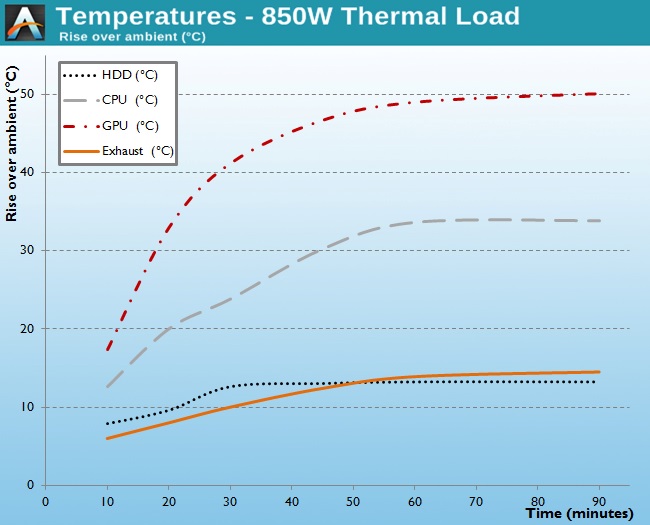
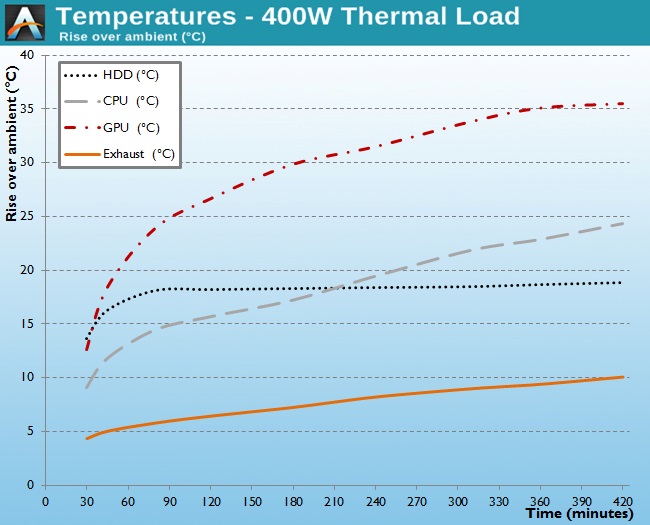
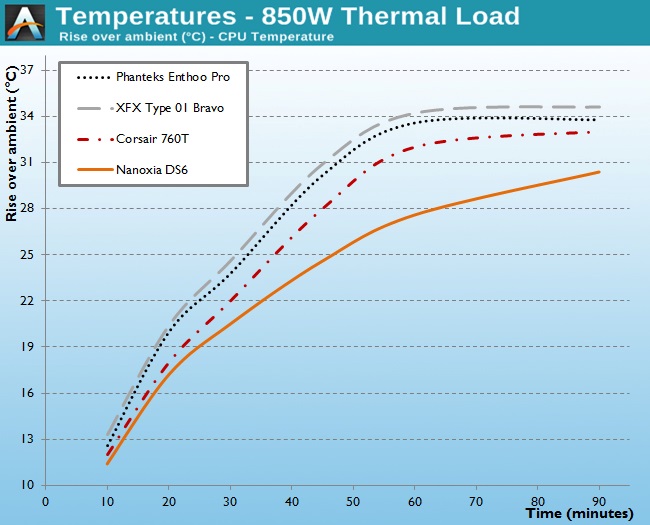
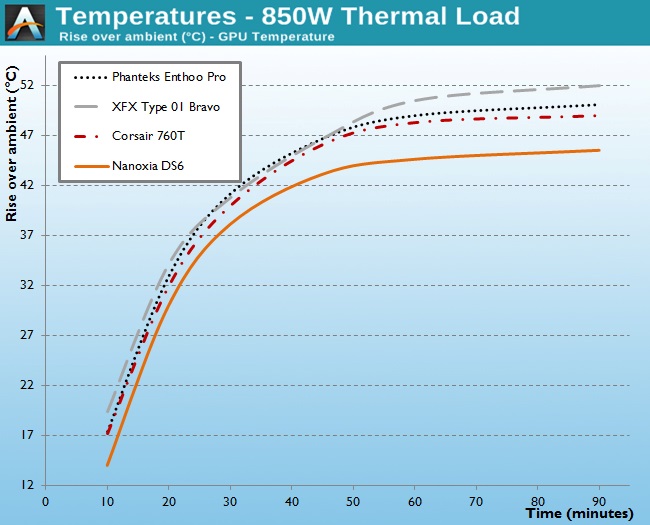
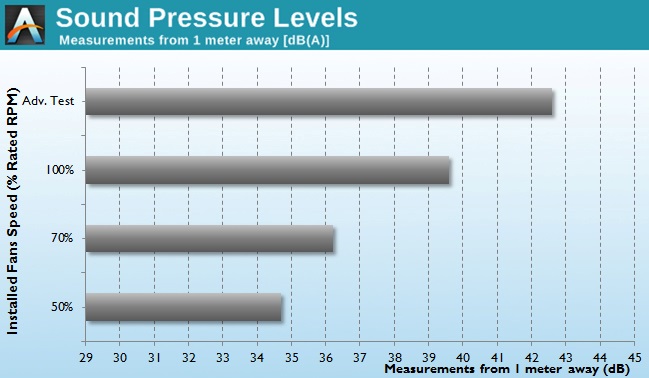








50 Comments
View All Comments
Haravikk - Wednesday, April 1, 2015 - link
Agreed. This case is incredibly unremarkable, and until more towers start ditching the obstructive and largely redundant up-front drive bays, we're not going to get much progress in the tower market.I don't know any gamers who really need more than two drives, or for whom 2.5" drives aren't sufficient. 4x 2.5" drive bays can squeeze in almost anywhere in a properly designed case, and would still let you have a pair of mirrored SSDs and mirrored HDDs (or striped if you prefer) which is about the most I expect anyone to have these days.
In terms of optical bays; so few people really use them anymore, meanwhile a slot-loading (or at least low profile) drive takes up hardly any space. The focus really does need to be on big fans up front with as little obstruction as possible.
Some people might mention fan controls, but any good pro case could include one with a custom fitting. But again, most people don't (or shouldn't) need a fan control, as any good motherboard can drive more than enough fans, so at most you might need a splitter cable, especially since most fans these days are pretty energy efficient, especially larger ones that don't need to spin very fast anyway.
So yeah, we're stuck with towers constantly being released with an obsolete internal design, and it's really hurting the market. Only smaller designs are really innovating at the moment, and even then some of them are making really weird decisions.
NLD - Wednesday, September 16, 2015 - link
You don't know because you don't know anyone... I'm a member of a gaming community and know over 50 in our community alone.....NLD - Wednesday, September 16, 2015 - link
get a laptop.Dug - Monday, March 30, 2015 - link
Define R5 lets you take all of them out giving you many options for radiators.NZXT S340 has no bays at all making the case fairly small for an ATX design.
nmm - Monday, March 30, 2015 - link
I would usually agree with you, but I tend to agree with some that the sentiment is more appropriate with compact cases. I just can't imagine there being a realistic need for a tower case with the entire front surface covered with radiators in addition to the top/bottom or whatever else. Just the same, I'd get more use out of a mini-fridge on the front of my case than 5¼" bays. That's because I'm not a person who has any need for a tower case, though. I'd rather build an efficient mini-ITX system than a 3 foot tall air circulator disguised as a computer.WithoutWeakness - Tuesday, March 31, 2015 - link
I think you're on to something with the mini fridge. Most cases with doors only have them to cover the ugly 5.25" bays. If we pull the 5.25" bays and replace them with a mini fridge that can hold a couple of cans then the door would actually have some functional purpose instead of just being for aesthetics.continuum - Tuesday, March 31, 2015 - link
Two went be plenty. Heck, lots of times, agreed that one would be enough, and zero is okay.Given it's an E-ATX case for $100 I don't mind seeing one or two (it's certainly big enough!) but yeah, three seems silly...
DanNeely - Wednesday, April 1, 2015 - link
Once you have a single 5.25 bay, you might as well have several, and a mess of 3.5" bays below, since you've stretched your case forward enough to accommodate them.The compact (front to back) single 5.25 bay case died when the market decided to move the PSU to the bottom and to use the top of the case for ventilation.
NLD - Wednesday, September 16, 2015 - link
5.25 bays are essential , Fan controllers, lighting controllers, Card drives, audio bays.... if you don't like them use the 100's of cases with no 5.25 bays.... I really think new cases need them, maybe more ascetics and innovation on how you can disguise or hide them is a good idea.Needless to say, fans of external Blu-ray players and DVD-HD writers etc... will not care but they are with good cases, 5.25 drive bays will live on.
nos024 - Monday, March 30, 2015 - link
I like my 5.25 bays...there has to be at least two. I am not ready to give up my ODD and swappable HDD bay. At least for large towers like this, I want to have 5.25 bays. I can see a mid tower case not having it. The point of a full tower case is that you can put ANYTHING you want in it.The problem with these large towers case is that the 8pin CPU power cord is barely long enough (and sometimes won't even reach). Given that the majority of PSUs are mounted at the bottom, I think it's time the PSU manufacture give you a longer cord...or the Motherboard manufacturers change it's location, or the case give you a better path. I see that this case has an opening at the top to route the cable to so it won't be a problem.